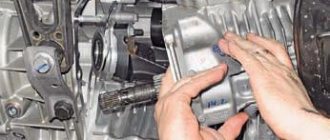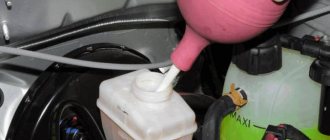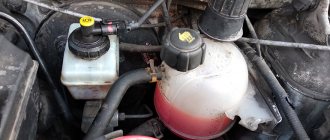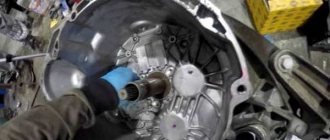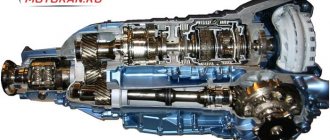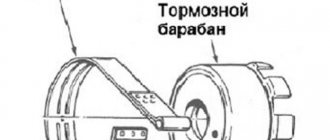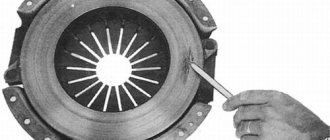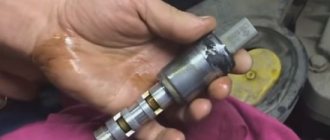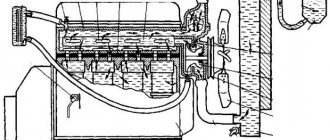If there is no normal transmission of torque between the engine and gearbox, the following measures must be taken:
- Check for leaks.
- Check the fluid level in the tank. If necessary, add fresh fluid.
- De-air the system by bleeding it.
- Inspect the circuit for leaks. If there are leaks, repair the damage.
- Check the condition of the working cylinder.
- Check the functionality of the release bearing. If it is broken, you should not delay repairs - damage to related components may occur.
On Renault Megane, clutch replacement is required in case of deformation of the discs or significant wear of the main parts.
If the clutch is lost far from the garage or car service station (for example, on the highway), you can continue driving the car. But you shouldn't change gears often. You should also adjust the engine speed to reduce the load on the gearbox when moving to higher or lower speeds.
How to bleed a clutch: preparation and stages
Clutch “diseases” can lead to problems at the start and when braking. Unfortunately, it is impossible to diagnose system problems based on external signs. Monitor its operation, pay attention to your own sensations when pressing the pedal, and if you notice jerks when starting the engine and switching the gearbox, go for diagnostics.
Car clutch system
Renault Fluence › Logbook › 16. Clutch replacement
Thank you all for the advice, answers and clarifications in the previous topic, thank you very much!
In general, the clutch wore out 157k km, everything is fair here =), my original battery has served me well for 7 years, probably in vain I was previously wary of the Renault brand.
1. Original clutch, assembled (article 302050901R), probably everyone has such a kit.
Below are the article numbers for the disk and basket from this kit; it may be cheaper to purchase separately.
2. Transmission oil “ELF TRANSELF NFJ 75W-80” for a manual transmission with the index “J...” (article 194757). Rear crankshaft oil seal, original (article 7701473544).
3. Release bearing Not everything turned out to be simple here, many gave different part numbers, but I found an article on how to determine which one is needed without making a mistake. Everything turned out to be elementary, open the hood and take a look =)
If there are two latches, then the article number of the original bearing is 306209222R, but the price tag for it is outrageous. Therefore, I went to the site in search of a replacement; the one I needed was on the left (circled in red), and the one on the right was for those who had one latch.
The car mechanics completed the replacement in half a day, I was very afraid of the oil seal being installed incorrectly, but the oil level is still in its original condition. Just the other day I broke a dipstick, the price of which is not adequate, maybe someone knows an analogue, please tell me.
Before replacement:
1. When starting (not a warmed up engine and very rarely a warm one), in first gear sometimes the car jerks, you have to play along with the gas pedal. 2. When the engine is not warmed up, a pulsating rustling noise is heard, the sound is clearly audible in the area of the left wheel and a little in the cabin; if you press the clutch, the rustling noise disappears completely. When the car was moving at low speed, releasing the gas, a rustling sound appeared, but if you give it more gas, it disappears. 3. With the advent of cold weather, on a not warmed-up engine (in fact, the bearing), with the clutch pedal depressed, a whistle appears from the release bearing, not very loud, but there is... 4. In traffic jams, stalling at start, rarely, but it happened. While I was waiting for spare parts, jerks appeared when changing gears.
After replacement:
All of the above items are missing. The clutch now engages at the very beginning, but this is said to be temporary until the pedal adapts. In general, the car is now unrecognizable, it’s not customary, the pedal is depressed without any effort =) They also gave out a list of dead front suspension components, fortunately half of the spare parts are lying in the trunk, purchased a year ago (the result of faulty diagnostics).
Source
Necessary tool
To bleed the clutch you will need:
- New brake fluid, in our case ROSDOT 4.
- Medical syringe 20 ml (preferably 50 ml).
- A transparent hose at least 1 meter long (will be used in conjunction with a syringe, so the diameter must be appropriate). You can use a dropper kit; it already has a clamp to shut off the air flow.
- Stationery clip.
- Container for processing.
- Rags.
Tool required for bleeding
In order to start bleeding the clutch we will need:
- Brake fluid of the brand intended for your car.
- Medical syringe.
- Small hose. (Good fit from the windshield washer system VAZ 2108-99).
- Container for draining old fluid.
The tool is ready for use
Step-by-step work order
There is a Renault Megane 2 fitting located here, which is designed for bleeding the clutch system (working cylinder).
The fitting is visible under the hood with the naked eye.
- Next, for convenience when performing work, remove the battery and dismantle the platform under it.
- Then remove the cap from the brake fluid reservoir and add fluid to the maximum mark.
- We clean the plug on the fitting from dirt and remove it.
Clean carefully so as not to damage the surface of the cap.
In order to put on the hose, you will have to make a small effort
The best option is a 20 cc syringe
We take it out carefully so as not to break it
In order to remove the tube from the place of fixation, only a little force should be applied
This procedure will have to be done more than once.
Next, when your syringe is full, you must first push the black tube back into place (to prevent air from getting in), and only then disconnect the syringe from the hose and pour out the pumped out liquid. Then we put everything back in place and continue working.
- A similar procedure should be carried out until all air bubbles are released from the system. As a rule, such manipulations take about 2-3 repetitions.
- Do not forget to constantly monitor the level of brake fluid in the system through the brake fluid reservoir, and top it up if necessary.
Fill the liquid within the MAX level
Important!
Please note that it is unacceptable to reuse used, previously drained hydraulic fluid, or to use or mix different types of it together. In addition, if you accidentally spill hydraulic fluid on the car body, you should immediately clean the area of contamination and rinse it with water!
Preparatory work
For optimal and stable operation of the hydraulic drive system, it is necessary to monitor the condition of its systems in general and, in particular, the absence of air in it.
To avoid pumping, you should use only clean liquid and only the brand recommended by the manufacturer. In our case, this is ROSDOT 4.
When mixing different types of hydraulic fluid, you should change it and install new O-rings. In case of regular leaks, the location of the leak should be determined and the identified damage should be repaired. Remember that poorly performed work on pumping hydraulic drive fluid can cause unnecessary replacement of parts or erroneous diagnosis.
Bleeding and replacing the Renault Megane 2 clutch
When carrying out repairs on the clutch, you should buy the entire kit. Due to the low cost of the Renault Megane 2 kit, we recommend replacing it entirely.
Replacing cylinders with your own hands Based on which particular cylinder has failed, you should determine the algorithm for replacement work. If the main unit wears out, it should be replaced from the interior part, because the part is located immediately behind the clutch pedal.
Renault Megane clutch replacement
Replace the release bearing, having previously lubricated its sliding areas. Reinstall the gearbox, then tighten the bolts along the bottom of it. Reinstall the drives and subframe, not forgetting the cushions. Fill the box with oil, preferably new. Reassemble the remaining nodes in reverse order.
How to Adjust the Clutch on Renault Megane 2
Clutch adjustment, bleeding and replacement in Megan 2.7
It's no secret that clutch control plays an important role in the proper operation of any car. Most often, it is probably Renault Megane who are faced with the problem of a faulty engine-to-box transmission mechanism. Now let's talk about the signs of defective adhesion and how to eliminate them.
If the clutch is gone
A more common type of clutch failure is a worn head, as this is also called the compression slave cylinder. Second point. This is critical wear on the disc and other clutch kits. A large percentage of breakdowns are manifested by extraneous noise when pressing the pedal. This symptom indicates a faulty release bearing. These faults negatively affect the clearance clearance.
When repairing the clutch mechanism, you must obtain a kit.
Because the Renault clutch
The 1st generation Megan is inexpensive, we recommend replacing it completely.
Cylinder change
What is the duration of the project, what cylinder is on, you need to choose a specific shift strategy.
- If the master cylinder is worn, it should only be replaced internally, as this part is specifically mounted on the clutch pedal.
- If the passage, if the suspension cylinder is worn out, it will not be superfluous to change it, although you will have to work hard. To do this, unscrew the hydraulic line, then remove the cylinder from the gearbox. The new slave cylinder
is installed in the reverse order of removal and then adjusted.
Warning! In any case, the clutch system requires bleeding, keep this in mind.
We're pumping the system
It is enough to fill the tank with DOT4 fluid to bleed the hydraulic line.
Later we perform the pumping function with a partner. One presses the master cylinder pedal, the other opens the drain valve for a while. The adjustment procedure should be repeated until all the air is gone.
How the clutch should work on Megan2
How to pump the clutch
on machines with a hydraulic circuit,
the clutch
. Contact Information
Pumping the system
To bleed the hydraulic line, simply fill the reservoir with DOT4 fluid.
After this, together with a partner we carry out the pumping procedure. One presses the master cylinder pedal, while the second opens the bleed valve. The adjustment procedure must be repeated until all the air has escaped.
There is another way that will help you do this operation alone.
- Take a medical syringe with a volume of 20 cubes, put a hose of a suitable diameter on its spout.
- Fill it with brake fluid and place the end of the hose on the bleeder fitting of the working cylinder.
- After unscrewing the fitting, slowly squeeze the liquid out of the syringe, then close the fitting and remove the hose.
In most cases, one procedure is sufficient.
Sequence of actions when bleeding the Renault Megane 2 clutch
The entry of air into the hydraulic drive causes poor clutch operation, which makes it difficult to engage gears, and in some cases it becomes completely impossible to change gears. To fix the problem, you need to bleed the clutch; on a Renault Megane 2, this work is not difficult to do, but you need to know the sequence of actions and some features.
- 1 When to bleed the clutch
- 2 Procedure for bleeding the Megane 2 clutch
- 3 Features of replacing brake fluid in the clutch 3.1 Related articles:
When to bleed the clutch
Airing of the hydraulic clutch drive (HC) occurs for various reasons:
- due to a faulty master cylinder;
- when there is a brake fluid leak;
- due to a leaky connection in the clutch hydraulic system, for example, between the tube and the working cylinder (WCC).
If air gets in, the clutch needs to be pumped, and the GPS pump is also needed to be pumped after replacing, removing and installing parts in this system; DOT-4 type brake fluid is used to fill the channels and pump it on Megan’s car.
Procedure for bleeding the Megane 2 clutch
As with almost all other passenger cars with a manual transmission, bleeding on the Renault Megane is performed by bleeding air from the control valve fitting, and this work can be carried out by one person, without an assistant. Before performing the operation, we prepare everything you need, you will need:
- a piece of transparent hose, suitable for the windshield washer system;
- container for draining brake fluid (TF);
- standard medical syringe;
- bottle with new liquid DOT-4.
Now you can get to work, first of all, open the hood and remove the filler tank cap, top up the fuel fluid to the top level.
The following is the procedure:
- For convenience, we remove the battery;
- under it at the gearbox we find the RCS, there is a fitting on it, onto which we attach a transparent hose, having first removed the cap;
- At the other, free end of the tube we attach a syringe;
- there are two clamps on the RCS, and the one that is recessed is raised up, the other clamp located above, on the contrary, is recessed (lowered);
- the black tube, which is in the photo above, is located to the right of the cylinder, blocks the access of liquid to the fitting, and when the position of the clamps changes, it can move. We move the tube to the right approximately 5 mm, thereby freeing up the channel for pumping;
- use a syringe to extract the fluid from the system; first, air will come out along with the liquid;
- having filled the syringe full, or install the black tube in place, again swapping the clamps, or pinch the transparent hose to recharge the syringe, such actions must be done to avoid air getting into the line;
- do not forget to constantly add liquid to the tank, otherwise the GPS may become airy again;
- We carry out the operation until air bubbles no longer appear in the transparent hose; after pumping is completed, we put the black tube in place; it is also necessary to return the clamps to the reverse position.
Having filled the tank with fuel fluid to the required level, close its lid, and at this point the pumping can be considered complete.
Features of replacing brake fluid in the clutch
Brake fluid is hygroscopic; if it has accumulated moisture, brake fluid parts may corrode from the inside. Therefore, the vehicle must be changed regularly; replacement is usually done every 30,000 kilometers or once every 2 years (the second point is especially relevant if the car is rarely used).
Also, the fluid changes when it becomes cloudy (changes color), you should replace it even if you bought a used car and don’t know what’s in the tank. To flush the system, you should use only the fluid recommended by the manufacturer; other products and brands cannot be used here.
Replacing cylinders
Depending on which cylinder is worn out, you need to choose a specific replacement tactic. Renault Megane 2 clutch installation
If the master cylinder is worn out, it only needs to be changed from inside the car, since this part is installed directly under the clutch pedal. If the clutch slave cylinder is worn out, replacing it will not be too difficult, although you will have to work hard. To do this, you need to unscrew the hydraulic line, and then release the cylinder itself from the gearbox. The new working cylinder is installed in the reverse order of removal, after which adjustment is required.
Attention! In both cases, the clutch system requires bleeding, do not forget about this.
Let's sum it up
Of course, many Renault Megane owners may be intimidated by the amount of work that needs to be done to replace the disk. But as they say, “the devil is not as scary as he is painted,” and if you have the opportunity to rent a box with a tool and a lift, you can easily carry out all the work. After assembly, you will be pleasantly surprised by the quality of the work done.
| Category overview |
| [td] Tires Contact information |
| Working hours: Mon - Fri: 9-18.00 Sat: 9-14.00 Sun: closed arnage-market 475-651-961 [email protected]Cherkassy 145 Shevchenka Blvd., office 251 BC Ukraine © 2009 — 2010 Online store of auto products and auto parts34 Article rating: Bleed clutch Renault Megane 2 Link to main publication Related publications
|
